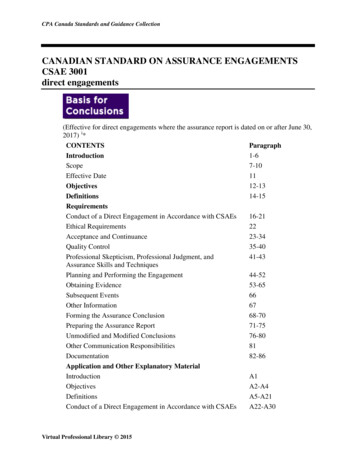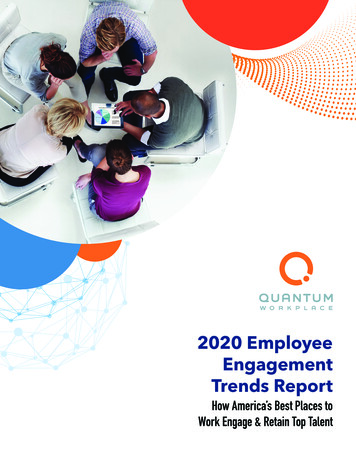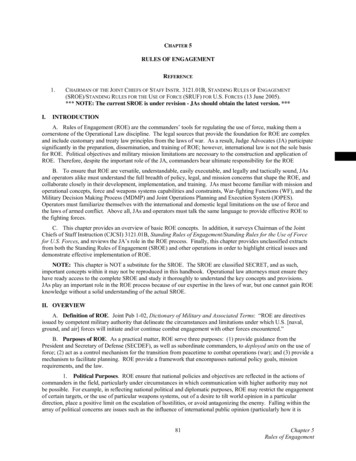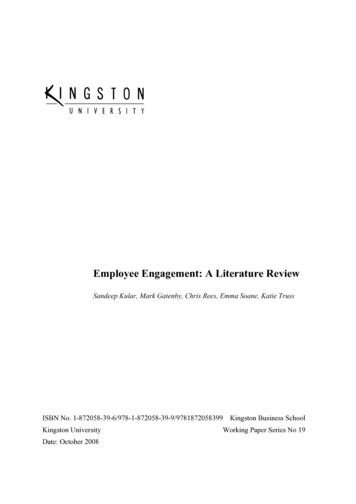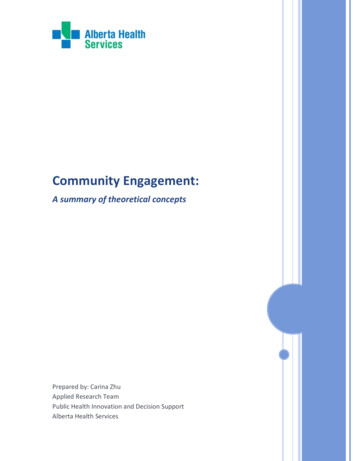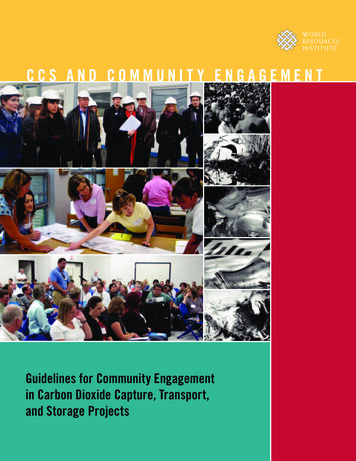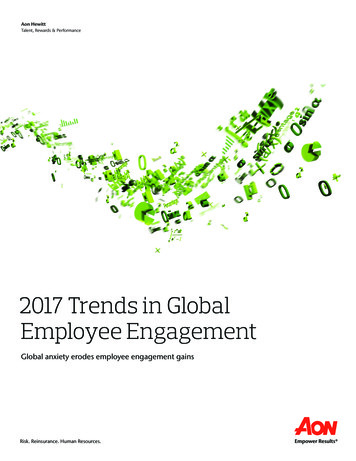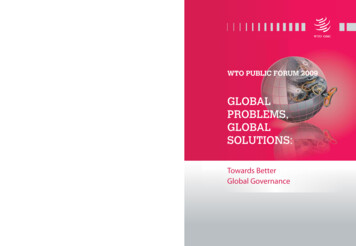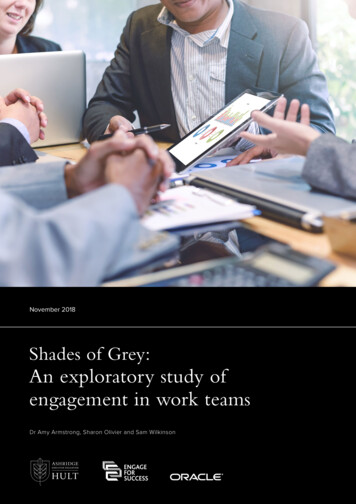
Transcription
TheGlobal Study ofEngagementDr. Mary Hayes, Dr. Fran Chumney,Dr. Corinne Wright, Marcus Buckingham
ExecutiveSummaryThe ADP Research Institute (ADPRI) surveyed over 19,000employees across the globe to measure their levels ofEngagement and identify what conditions at work are mostlikely to attract and keep workers.We research Engagement because it matters to employersand their workers. A disengaged workforce costs the globaleconomy billions of dollars annually. When employees arenot fully engaged, organizations suffer.Employees with reduced Engagement are 45% more likely tovoluntarily leave their organization (Nine Lies about Work:A Freethinking Leader’s Guide to the Real World, in press).The cost of voluntary turnover ranges from a little overhalf the salary of a front-line worker, to nearly 2.5 timesthe salary of a knowledge worker or supervisor (LinkedIn,August 2013)!In contrast, companies with high Engagement performbetter — in terms of higher stock prices, higher productivity,lower turnover, and greater customer satisfaction. (Forbes,May 2017).Copyright 2018 ADP, LLC.2
TheStudyIn July 2018, ADPRI surveyed a random sample of 19,346full-time and part-time employees across 19 countries.This study repeated a similar global study conducted in2015 across 13 countries.The survey asked employees about many aspects of howthey view their work, including a validated eight-questionmeasure of Engagement developed over the last decade.Based on survey responses, we calculated the percentageof workers who are “Fully Engaged” in any team, company,or country, and looked at the conditions most likely to leadto being Fully Engaged at work.To determine if workers are Fully Engaged, we looked atthe extreme positives on each question, giving more weightto the questions with the strongest relationship to positiveproductive outcomes. The workers who were not FullyEngaged we describe, simply, as “Coming to Work.” Theseworkers aren’t necessarily disengaged; they just aren’tcontributing all they could.We believe that, combined with our 2015 study, this 2018study is the largest and most reliable study of global workerEngagement yet undertaken.Copyright 2018 ADP, LLC.3
What WeLearnedCopyright 2018 ADP, LLC.4
1Global Engagement levels have notchanged much in the past three yearsoverall, but Engagement in somecountries has shifted significantly.Only about 16% of employees are Fully Engaged, and thisnumber has not changed much since 2015. This meansthat 84% of workers are just Coming to Work instead ofcontributing all they could to their organizations.Location matters. Although the overall level remainedstable from 2015 to 2018, we found significant variationin percent of Fully Engaged by country. In eight countries(Argentina, Australia, Canada, France, India, Italy, Spain,and the United Kingdom) the percent of Fully Engagedincreased. In four countries (Brazil, China, Mexico, and theUnited States) the percent of Fully Engaged decreased.The UNITEDARAB EMIRATEShas the highestpercentage of FullyEngaged workersat 26%.CHINA showed thelargest decrease, witha 13-point drop inpercent Fully Engagedto 6%; it has the lowestpercentage of engagedworkers.INDIA showedthe largestincrease in thepercentage ofFully Engagedworkers, up byINCREASEDfive points to 22%.DECREASEDCopyright 2018 ADP, LLC.5
2Being on a team increases Engagement.Workers who say they are on a team are 2.3 times morelikely to be Fully Engaged than those who are not. Thisfinding holds true within all countries in the study, and inBRAZILmany countries the disparity between non-team and teamworkers is even greater:For example, in Brazil only 5% of non-team workers areFully Engaged, whereas 15% of team workers are Fully5%Engaged. Likewise, in Singapore 4% of non-team workersof NON-TEAMare Fully Engaged as compared to 22% of team workers.workers areIn the United States 11% of non-team workers are FullyFully Engaged.Engaged, whereas 19% of team workers are Fully Engaged.4%of NON-TEAMworkers areSINGAPOREFully Engaged.UNITED STATESOF AMERICA11 %of NON-TEAMworkers areWorldwide, 17%of TEAM workersare Fully Engaged.Fully Engaged.Copyright 2018 ADP, LLC.6
3Organizations do not understand or acton the vital power of teams.The challenge for almost all organizations today is that theyare not set up to know very much about their teams. Mostcurrent HR systems are extensions of financial systems andonly show their reporting structure via an organizationalchart. Yet, most work happens in functional teams that canbe fluid, depending on the project.Of those surveyed who say they work in teams, 64% reportthat they work on more than one team, and 75% reportthat their teams are not represented in their employer’sorganization chart.When organizations make great teams their primary focus —including what creates them and what can fracture them —we expect to see more significant rises in Global Engagement.64 %report that theywork on MORE75 %report their TEAMSare not representedin their employer’sorganization chart.THAN ONE TEAM.Copyright 2018 ADP, LLC.7
4Trust in team leaders is the foundationof Engagement.When we examined the most engaged teams, we foundthat, by far, the best explainer of level of Engagement waswhether or not the team members trust their team leader.Of those who strongly agreed that they trusted theirteam leader, 45% were Fully Engaged. Of those who didn’t45 %of those who stronglystrongly agree, only 6% were Fully Engaged.agree that they TRUSTTHEIR TEAM LEADERImportantly, a worker is 12 times more likely to be Fullyare Fully Engaged.Engaged if he or she trusts the team leader.A worker is 1 2 x more likelyto be Fully Engaged if he orshe TRUSTS the team leader.Copyright 2018 ADP, LLC.8
5Knowing what is expected and usingone’s strengths make engaged teams.Two Engagement Pulse Statements in the survey showedthe strongest relationships to a worker’s feeling of trust inhis or her team leader:At work, I clearly understand what is expected of me.I have the chance to use my strengths every day at work.When a leader can help team members feel clarity aboutexpectations and communicate to them that their strengthsare recognized and appreciated, trust is built and a FullyEngaged team becomes more likely.12At work, I clearlyUNDERSTAND WHATIS EXPECTED of me.345I have the chance toUSE MY STRENGTHSEVERY DAY at work.678Copyright 2018 ADP, LLC.9
6Gig workers are engaged, especiallywhen they are part of a team.We looked at whether work status as a full-time, part-time,or gig worker affected employees’ sense of engagement.Interestingly, the most engaging work status is to have onefull-time job and one part-time job.Gig-only workers who are part of a team are also highlyengaged.21% of full-time gig workers reported they were FullyEngaged.The two questions where the gig-only workers scoredlower than traditional workers were: ‘I am surrounded by25% of those who have this status say they were FullyEngaged compared to an average of 16% Fully Engaged forthe other categories.A possible explanation is that a full-time job brings stabilityand benefits, while the part-time role brings the chanceto do something the worker truly enjoys (as well as someadditional earnings).people who share my values,’ and ‘My teammates have myback.’ This suggests that gig-only workers can feel moreisolated than other sorts of workers.However, when we examined gig-only workers who werealso on a team, there was no difference on these questionsbetween gig workers and employees. This implies that gigwork does not necessarily have to be isolating, and that allworkers are more engaged when they can work on teams.GIG andFULL-TIMEWORKERS aremore engagedwhen they canwork on teams.21 %15 %of full-timeof FULL-TIMEGIG WORKERSWORKERSreported they werereported they wereFully Engaged.Fully Engaged.Copyright 2018 ADP, LLC.10
7Virtual workers are more engaged;those who travel are less engaged.In all countries and industries, virtual workers who arepart of a team are more likely to be engaged.29% of virtual workers were Fully Engaged compared to18% who work in an office.This suggests that physical proximity is not required tocreate a sense of team, and that the flexibility and easeinherent in working virtually is appealing to all workers.Working virtually is not the same as traveling for work.Those workers who reported that they traveled for workdisplayed the lowest levels of engagement.Only 11% of road warriors are Fully Engaged compared to15% for non-traveling workers.29 %of VIRTUAL WORKERSare Fully Engaged.18 %of OFFICE WORKERSare Fully Engaged.15 % of NON-TRAVELING workers and11 % of ROAD WARRIORS are Fully EngagedCopyright 2018 ADP, LLC.11
8More educated and higher levelworkers are more engaged.Workers with higher levels of education and higher positionin an organization are both more engaged.19% of those with an advanced degree are Fully Engagedcompared to 12% for those with no college education.24% of C-suite/VP-level workers are Fully Engaged12 %compared to 14% of mid-level and first-level team leadersand 8% of individual contributors.of those withNO COLLEGEEDUCATION areThis is probably due to a number of factors, includingcompensation, having invested more time and effort toFully Engaged.get there, and being clearer on what they want to achieve.These numbers are consistent with ADPRI’s turnover datathat shows higher turnover at the entry-level positions.8%19%of those with anof INDIVIDUALADVANCED DEGREEcontributors areare Fully Engaged.Fully Engaged.14 %of MID-LEVELand FIRST-LEVELteam leaders areFully Engaged.24 %of C-SUITE/VP-LEVELworkers are Fully Engaged.Copyright 2018 ADP, LLC.12
9Millennials are slightly lessengaged than Boomers.Age does not seem to be a significant factor in engagement,contrary to our initial hypothesis.16% of Millennials are Fully Engaged compared to 18%of Boomers.We believe other factors, such as being on a team andusing one’s strengths, are more important.16 %of MILLENNIALSare Fully Engaged.18%of BOOMERSare Fully Engaged.Copyright 2018 ADP, LLC.13
10Women are slightly moreengaged than men.Since there are more men at higher levels in organizations,we thought men might be more engaged, but gender doesnot make much difference.Globally, 17% of women are Fully Engaged compared to15% of men.Given the large sample sizes, these differences arestatistically significant, but a two-point difference such asthis is not practically significant.17 %15%of WOMEN areof MEN areFully Engaged.Fully Engaged.Copyright 2018 ADP, LLC.14
TeamWorkEmployee engagement can be complex on the individualand even organizational level, but one over-arching factoremerged: working on a team improves engagement.Regardless of demographics, work status, or wheresomeone works, being on a team increases employeeengagement. But teams are not the same as the org chart.It’s important for everyone, including gig workers, toregularly work with others, have a sense of belonging, andtrust their leaders.Copyright 2018 ADP, LLC.15
About ADPPowerful technology plus a human touch. Companies ofall types and sizes around the world rely on ADP’s cloudsoftware and expert insights to help unlock the potentialof their people. HR. Talent. Benefits. Payroll. Compliance.Working together to build a better workforce. For moreinformation, visit ADP.com.About the ADP Research Institute The ADP Research Institute provides insights to leadersin both the private and public sectors regarding issuesin human capital management, employment trends, andworkforce strategy. ADP.com/researchThe ADP Logo, ADP, and ADP Research Institute are registered trademarks of ADP, LLC. All other trademarks and service marks are the property of their respective owners. Copyright 2019 ADP, LLC. All rights reserved.16
We looked at whether work status as a full-time, part-time, or gig worker affected employees’ sense of engagement. Interestingly, the most engaging work status is to have one full-time job and one part-time job. 25% of those who have this status say they were Fully Engaged compared to


